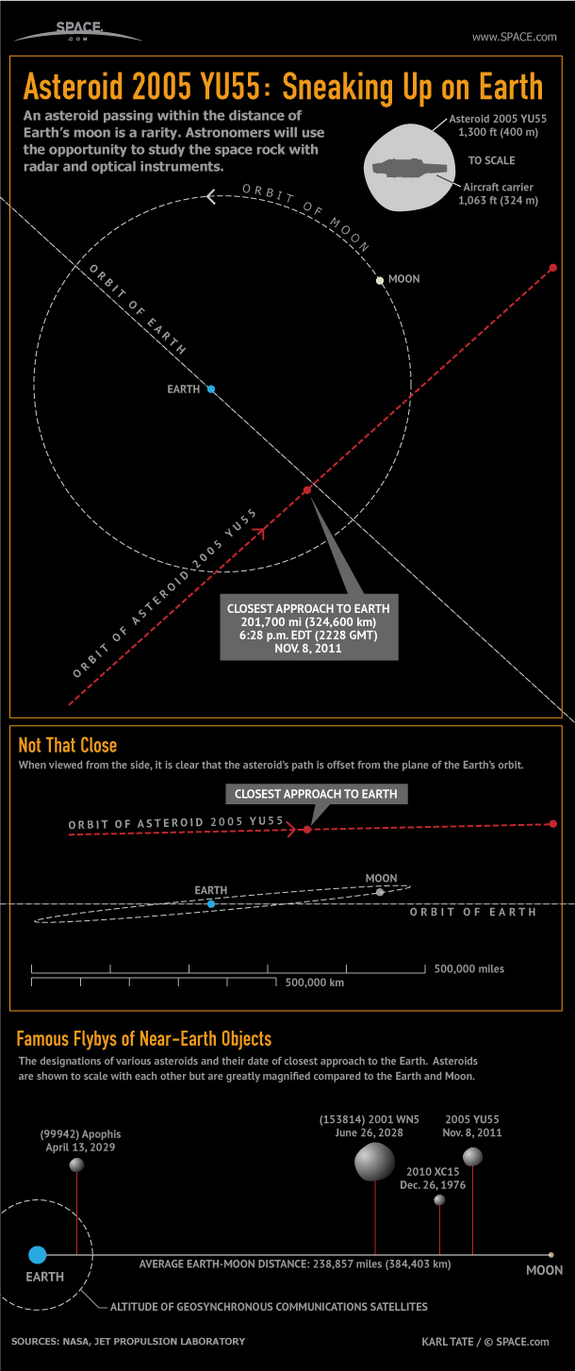An asteroid drive by today and Sunspot 1339
This week ahead there are a couple of things to watch for up in space. The first one seems like something to be concerned with but it’s really not. I promise…. even though this thing on the right looks like something out of the movies.That is an asteroid which will make a close pass to the Earth.
The shadowy image is from the asteroid 2005 YU55 it will do a drive by to the Earth on Tuesday November 8th, 2011. It’s going to actually pass between us and the moon, which is REALLY close. Only about 220,000 miles which in space terms and distances is very close, that’s just 6/10th of the distance to the moon!
According to NASA’s Near Earth Object Program:
Although classified as a potentially hazardous object, 2005 YU55 poses no threat of an Earth collision over at least the next 100 years. However, this will be the closest approach to date by an object this large that we know about in advance and an event of this type will not happen again until 2028 when asteroid (153814) 2001 WN5 will pass to within 0.6 lunar distances.
Observing the asteroid:
It’s going to be hard to see this unless you have some pretty good backyard astronomy equipment. Mainly a 10-12” telescope with one or more standard filters. You’ll also need to be in a very dark location. Even then you’ll be fighting the full moon. Here are some tips from Sky & Telescope.

Source: SPACE.com: All about our solar system, outer space and exploration
In case you were wondering below is a list of some near earth asteroids over the next 2 months.
Near Earth Asteroids |
Potentially Hazardous Asteroids (PHAs) are space rocks larger than approximately 100m that can come closer to Earth than 0.05 AU. None of the known PHAs is on a collision course with our planet, although astronomers are finding new ones all the time.
Recent & Upcoming Earth-asteroid encounters:
| Asteroid | Date(UT) | Miss Distance | Mag. | Size |
| 2011 UX255 | Oct 28 | 0.4 LD | — | 15 m |
| 2011 FZ2 | Nov 7 | 75.9 LD | — | 1.6 km |
| 2005 YU55 | Nov 8 | 0.8 LD | — | 200 m |
| 2011 UT91 | Nov 15 | 9.9 LD | — | 109 m |
| 1994 CK1 | Nov 16 | 68.8 LD | — | 1.5 km |
| 1996 FG3 | Nov 23 | 39.5 LD | — | 1.1 km |
| 2003 WM7 | Dec 9 | 47.6 LD | — | 1.6 km |
| 1999 XP35 | Dec 20 | 77.5 LD | — | 1.0 km |
| 2000 YA | Dec 26 | 2.9 LD | — | 80 m |
| 2011 SL102 | Dec 28 | 75.9 LD | — | 1.1 km |
Notes: LD means “Lunar Distance.” 1 LD = 384,401 km, the distance between Earth and the Moon. 1 LD also equals 0.00256 AU. MAG is the visual magnitude of the asteroid on the date of closest approach.
Sunspot 1339
The other thing to watch for this week is the sun. The biggest sunspot so far of this solar cycle is now  facing the earth. This means the potential for a large solar flare directed at earth is increasing. Sunspot 1339 has the potential to produce a large X-Class flare. Right now there is about a 20% chance of that happening. If this sunspot launched a Cornal Mass Ejection or CME towards earth we would see a massive geomagnetic storm. This storm will cause communications and electronics failures. Along with producing Aurora Borealis or northern lights well down into the south including the Carolinas.
facing the earth. This means the potential for a large solar flare directed at earth is increasing. Sunspot 1339 has the potential to produce a large X-Class flare. Right now there is about a 20% chance of that happening. If this sunspot launched a Cornal Mass Ejection or CME towards earth we would see a massive geomagnetic storm. This storm will cause communications and electronics failures. Along with producing Aurora Borealis or northern lights well down into the south including the Carolinas.
The sunspot has already unleashed one X-flare on Nov. 3rd around 2027 UT. A movie from NASA’s Solar Dynamics Observatory shows the extreme ultraviolet flash:


